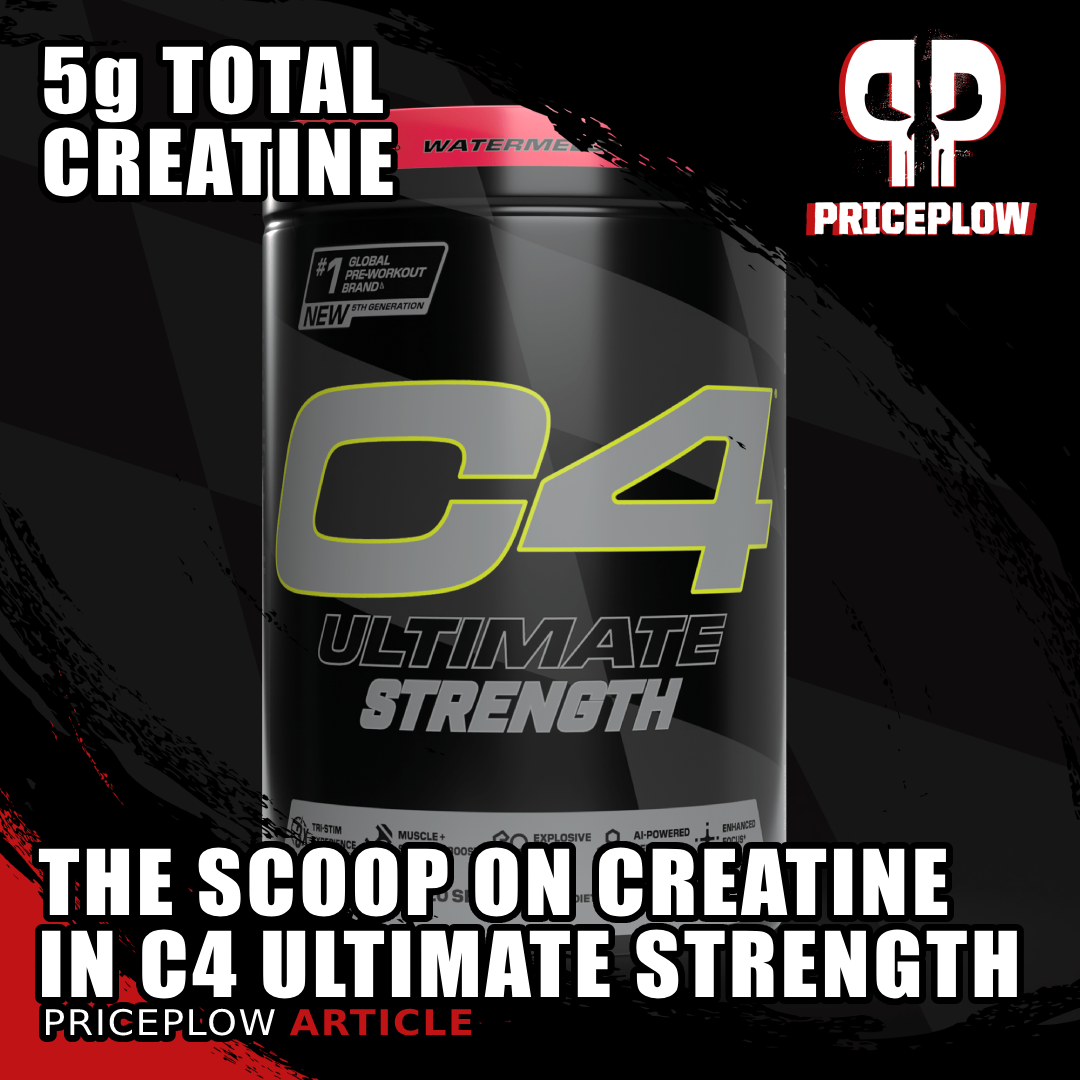
This pre-workout powerhouse features a clinically-supported dose of creatine to amplify power output, maximize muscle strength gains, and accelerate recovery. Dominate your workouts and push your limits with C4 Ultimate Strength.
February of this year, PricePlow was proud to announce to the world the new 5th Generation of C4 Pre-Workouts from NutraBolt. This long-awaited lineup brought some incredible innovations like an entirely new peptide-derived pump ingredient named PeptiPump, NSF Sport certifications for the beefed-up C4 Sport series, and the use of higher-quality B-vitamins in all products, including C4 Original.
But it was the C4 Ultimate Strength formula that grabbed the most attention, especially from our more experienced readers, thanks to its use of two sets of peptides (PeptiPump and PeptiStrong) and two forms of creatine. We went so far as to say it's the best C4 formula yet, and we stand by that.
An efficacious dose of creatine in your pre-workout?
Throughout its history, much of the C4 Series has been built atop creatine nitrate, a dual-use ingredient that provides some creatine, but is more experiential due to the nitrate-based pumps it has. However, nearly all clinical research uses more creatine than what's yielded in 1 or 2 grams of creatine nitrate.
So when building the Ultimate Strength variation, the development team at NutraBolt wisely went bigger, providing:
- 4g creatine monohydrate
- 1.5g creatine nitrate
...in every 1-scoop, 27.7g serving. That yields roughly 5 grams of creatine,[1] and generally 3-5 grams daily is considered the "clinical daily dose", although it's a bit more nuanced than that. Such a large dose of creatine is not that common in pre-workout supplements these days, however, making this a great differentiator for C4 Ultimate Strength.
So this article explores five main topics:
- A quick background on creatine
- The general benefits of creatine
- The role of creatine on training days
- The dosage nuances alluded to above
- Specific research on creatine nitrate
Before digging in, let's first let you check our current C4 Ultimate Strength coupon-based prices and availability, and have you sign up for C4 alerts on PricePlow:
Cellucor C4 Ultimate Strength – Deals and Price Drop Alerts
Get Price Alerts
No spam, no scams.
Disclosure: PricePlow relies on pricing from stores with which we have a business relationship. We work hard to keep pricing current, but you may find a better offer.
Posts are sponsored in part by the retailers and/or brands listed on this page.
This area is reserved for Team PricePlow's upcoming Ingredients video.
Subscribe to our channel and sign up for notifications so you catch it when it goes live!
First, if you wish to see an overall recap of this potent pre-workout, see our article titled "C4 Ultimate Strength: Dual Peptides Make for the Best C4 Formula Yet". Today we're just talking creatine.
A quick background on creatine
Without turning this into a biochemistry lesson, the quick two-word explanation for creatine is energy storage.
But we're not talking about energy in the form of "calories" or "fats" or "sugars"... we're talking molecular energy.
Reason being, creatine is stored in the muscle as creatine and phosphocreatine -- the phosphocreatine molecule contains an added phosphate group. These forms support cellular energy production,[2,3] because the phosphate group can be transferred to ADP (adenosine diphosphate) to create ATP (adenosine triphosphate),[4,5] the body's primary energy carrier.
Supporting ATP, the Body's Highly-Charged Energy Currency
When it comes to actual energy, ATP is what the body uses on a biochemical basis. It has three phosphate groups, and is a highly-charged molecule: The phosphate bonds are linked in a way that stores significant amounts of energy.
When a cell needs energy, it can break down ATP into ADP (adenosine triphosphate to adenosine diphosphate), which releases a large amount of chemical energy. This is the basis for energy production in life.
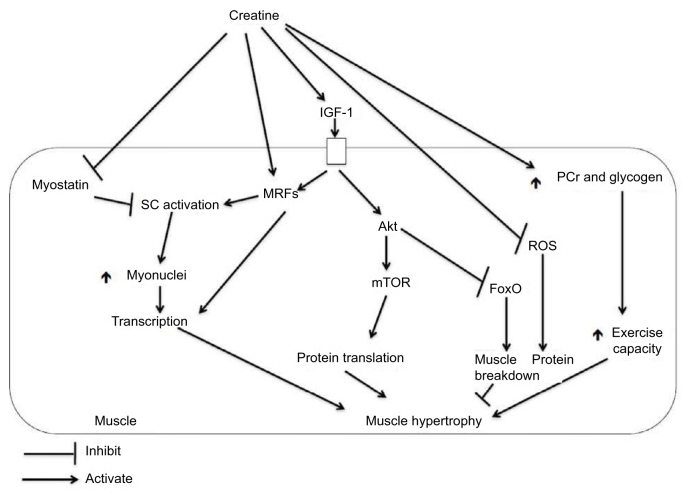
The potential mechanisms in which creatine supplementation supports and leads to muscle hypertrophy (muscle-building).[6]
Although the body can create its own creatine if you don't obtain it from diet or supplements, this process is metabolically-expensive.[7] A better solution is to eat foods high in creatine, such as meat, and to supplement with it.
Because creatine is so supportive of general energy production, this is why we see such diverse benefits from ingesting more -- it's not just about muscle health. However, since creatine is stored in muscle, the muscular benefits were first to be studied and are the most well-established.
Let's get into those benefits now:
The well-researched benefits of creatine
With decades of research on creatine, we can go well beyond citing individual studies -- there are numerous meta-analyses demonstrating its efficacy, especially in terms of muscle health and cognition when combined with resistance training and/or vigorous exercise.
Creatine meta-analyses on athletic / physical performance
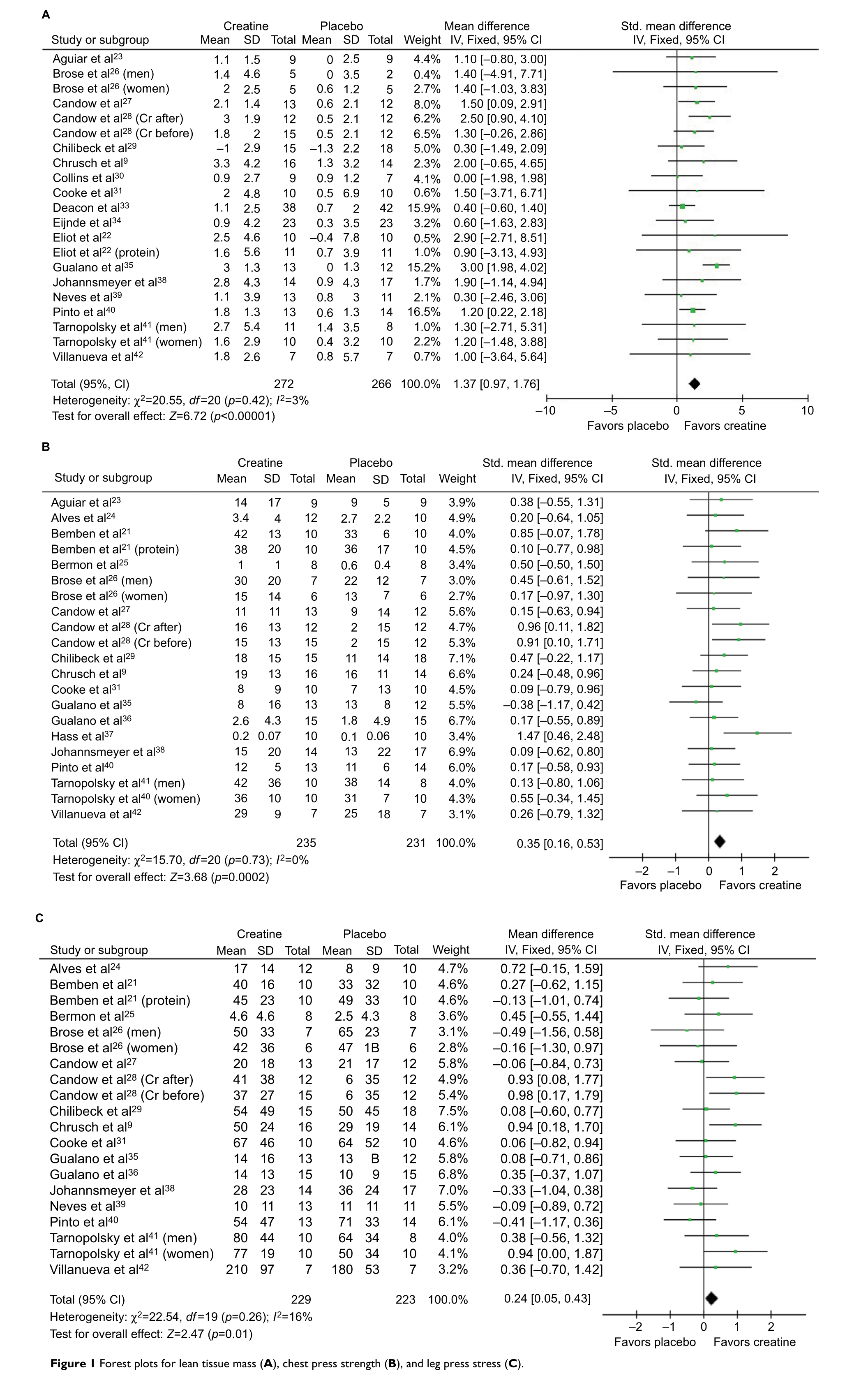
A 2017 meta-analysis showed that creatine consistently improves muscle mass, bench press strength, and leg press strength in older people.[6]
These benefits aren't just one-offs -- below are benefits of creatine demonstrated through statistical meta-analyses of numerous studies:
- Overall body composition[6,8,9]
- Lean body mass[8-14]
- Workout performance[8,9,15]
- Muscular strength[6,9,11,13,15]
- Bone mineral density[10,11]
- Anaerobic performance[16]
- Power output and speed during repeated sprints[14,17]
There are other benefits that have been found in single studies, including increased testosterone,[18-20] but the above list is what's been shown at a meta-analytical level.
We're at the point where anyone interested in the above benefits- which is nearly anyone athletic -- should be considering creatine. And if you dig deeper into the research, many studies land on 5 grams daily. We'll get into dosing below
Next, we cover a more recent development in creatine research -- cognition:
Creatine meta-analyses on cognitive performance
Unsurprisingly, supplying more biochemical energy is great for the brain, too! The scientific community now has enough research to provide us with two meta-analyses on this topic, finding that creatine improves:
- Intelligence/reasoning in healthy individuals.[21]
- Short-term memory performance[21,22]
We often point out that these effects are especially useful for vegans and vegetarians,[23-26] and the first meta-analysis confirms this, stating "Vegetarians responded better than meat-eaters in memory tasks".[21] This makes sense given the lower creatine intake in a vegetarian/vegan diet.
Worth for those who aren't getting the best sleep: One study even showed improved mood and cognitive performance when sleep-deprived for 24 hours![27]
Creatine only on training days?!
When talking about a pre-workout supplement with creatine, the question arises, "What about off-days?"
The general answer is to find a way to use creatine daily, or boost meat consumption if not supplementing it. There are two schools of thought when considering a creatine-based pre-workout:
- On one hand, athletes are more "strict" about taking their pre-workouts, so creatine's tougher to forget when it's already included.
- On the other hand, not everyone uses a pre-workout supplement every day, which means they'll want to remember to take creatine on their off days.
To fill the off-day gaps, or to add in a loading protocol (see next section), Nutrabolt sells Cellucor COR-Performance Creatine at very affordable prices.
The best answer is to do whatever works for you... get to saturation and stay there.
But what does the research say? It seems that if using it only on training days, there will still be benefits over placebo, especially at this 5 gram dose (we'll get into dosing in the next section). If this is the case, though, we hope it gets used 4-5 times per week.
One of the meta-analyses mentioned above that found improved lean body mass and muscular strength states that "Older adults who ingested creatine only on resistance training days experienced greater gains in measures of lean tissue mass and strength compared to the placebo".[13]
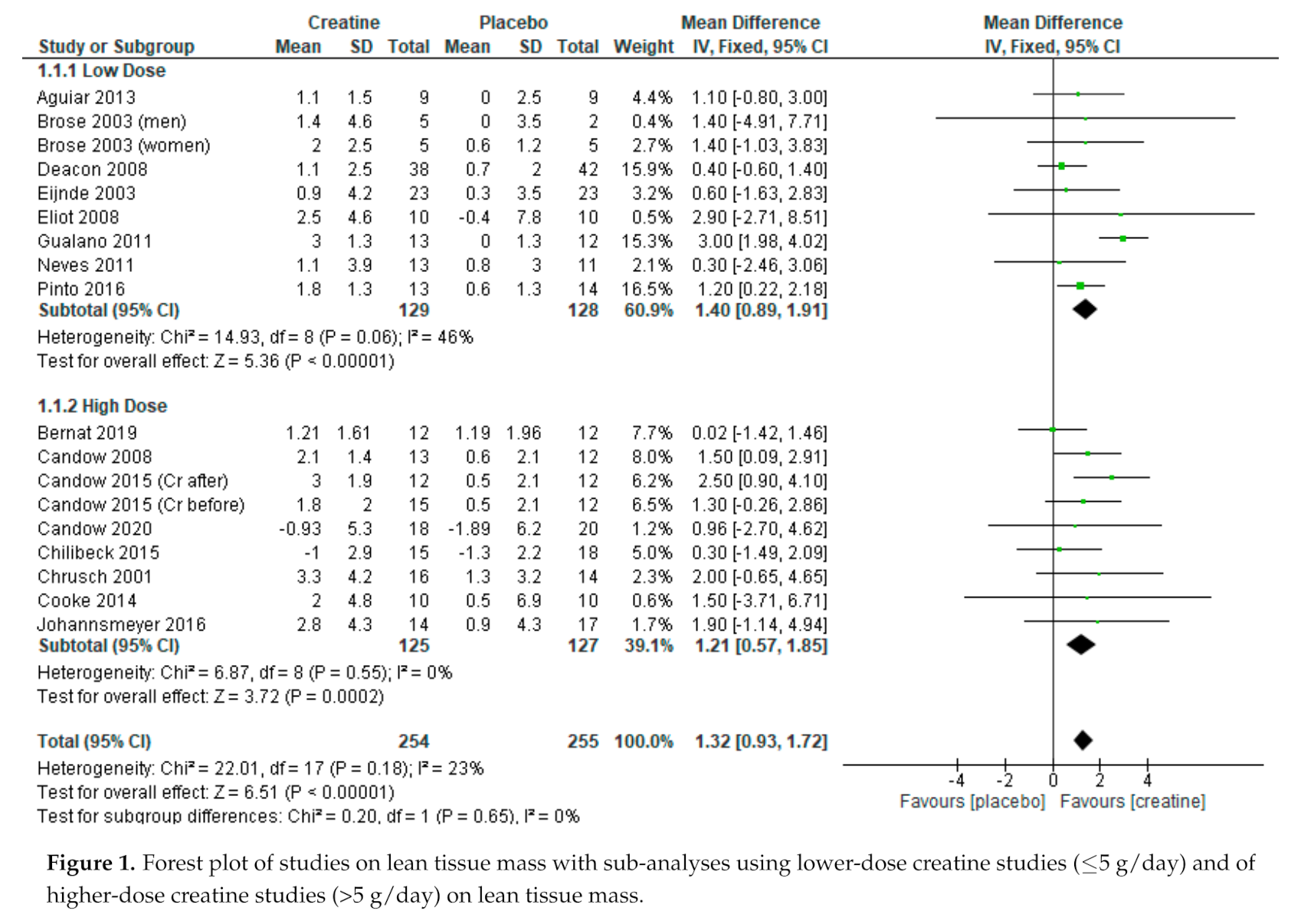
A 2021 meta-analysis showed that both high-dose (>5g) and low-dose (<5g) creatine led to great lean mass improvements in older people.[13] For them, normal 3-5g doses are fine -- we reserve the high-doses and loading strategies for big guys and young aggressive guys.
However, it also goes on to say that "A common theme across all studies was that creatine was consumed within 60 min' post-exercise."[13] So this isn't a perfect apples-to-apples comparison. Many of the studies that include carbohydrates utilize it during the workout, and are looking for longer-term trends.
Long story short? We're every day creatine supporters -- but if you are working out 4 or 5 times a week with C4 Ultimate Strength, we don't see too serious of a problem with missing a day. Just make sure you get enough meat in on your recovery days!
Creatine dosing strategies
So how much creatine should someone get in? If you want the "TL;DR", our super hot take for our healthy, athletic readers is simply this: 5 grams per day for guys, 3 grams per day for girls.

A 2019 meta-analysis showed that creatine improved anaerobic performance specifically in soccer players.[16]
But the real answer is everyone's favorite thing to hear: it depends. Three main variables come into play:
- How much muscle mass you have
- How much meat you eat
- How hard you're training
Let's take a look at input vs. output:
Creatine excretion
Males excrete two grams of creatine per day on average[7] - but it really depends on your muscle mass and size. Men use about 1.6-1.7% of their creatine stores per day,[28,29] and women lose a touch less.[7]
So, if nothing else, men will want to ingest at least two grams of total creatine per day -- but that's if you're already at saturation. If you're training hard and not at saturation, you'll never get there without boosting it more.
To boost it, the two strategies are simple - eat more meat or supplement it. So let's look at meat:
Creatine in meat

The most epic list of creatines you'll ever seen, broken down by molecular weight and percentage of creatine.[1]
Creatine is most abundant in beef -- researchers find roughly 2-2.5 grams of creatine per pound of uncooked red meat.[30,31] Chicken comes in slightly lighter, with 1.5 grams per pound.[31]
So, unless you're eating at least a pound of meat per day -- which we're definitely not against -- it's extremely wise to supplement it and save your body the metabolic burden[7] of having to create its own.
Creatine loading and common study doses?
As mentioned above, creatine is about saturation. You can likely get there with 3 grams per day, but you'll get there a whole lot faster at 5 grams per day.
However, there's a lot of early research using a loading protocol, such as:
- 20g daily for 5-7 days
- 3-5g daily in perpetuity
Several of the meta-analyses above discuss the topic of loading,[8,12-14,16] some working diligently to differentiate those studies from the rest. Back in the 1990s and 2000s, naysayers claimed that loading was only to get you to buy more creatine (it was quite expensive back then), but one meta-analysis notes the following:
"ES [Effect Size] was greater for change in BC [Body Composition] following a loading-only CS [Creatine Supplementation] regimen compared to a maintenance regimen."[8]
Additionally, research has shown that phosphocreatine stores are greater following loading protocols,[14,33-35] and that is, ultimately, our physiological goal with this ingredient.
So if you're creatine-naïve, and want to follow the most research ad get there quicker, it's not too expensive to load COR-Performance Creatine for 5 days -- you can add 15 grams post-workout (C4 Ultimate Strength already has the other 5 grams), or take 20 grams on off-days.
Necessary? Probably not. Optimal? We think so.
Creatine nitrate
Finally, we have to touch on creatine nitrate, a mainstay in many Cellucor / C4 supplements over the years. Creatine monohydrate makes up nearly all of the research discussed above - it's the tried-and-true standard, which is why there's 4 grams inside.
However, creatine nitrate definitely ups the ante. The nitrate portion promotes its own set of benefits, mainly surrounding its ability to boost nitric oxide production[36,37] and blood flow[38] through a unique pathway that's different from the typical citrulline/arginine pathway.[39-41] The athletic benefits from this covered in detail in our main C4 Ultimate Strength article.
Looking at research on solo creatine nitrate itself (admittedly in higher doses than the 1 gram we have here), we've seen it significantly increase bench press power,[32,42,43] leg strength,[42] and leg press endurance.[42] It also has a great safety profile.[32,44]
With these sources combined, we get about 5 grams of creatine in a full serving of C4 Ultimate Strength -- exactly where we want to be.
There's of course more to this product than creatine, so you can always head back to our main C4 Ultimate Strength article to learn about the other ingredients.
Conclusion: Creatine is King, Get it In
When we first saw the C4 Ultimate Strength formula, we couldn't have been more excited. The dual-peptide pump/power blend from PeptiStrong and PeptiPump stole the headlines, but something as simple as combining legit doses of creatine monohydrate and creatine nitrate in a pre-workout is what put it over the top.
We'd like to think that everyone eats 2 pounds of meat everyday, or takes their 3-5 grams of creatine, but not everyone is going to do either of those. In those cases, putting creatine into the pre-workout is a great way to go.
There's simply too much research on this molecule to ignore. It's safe and effective by insane margins. The only question is how you get it in. And if you like it pre-workout, C4 Ultimate Strength is a fantastic way to do it.
You can see our C4 Ultimate Strength price listings below, or head back to our main C4 Ultimate Strength article.
Cellucor C4 Ultimate Strength – Deals and Price Drop Alerts
Get Price Alerts
No spam, no scams.
Disclosure: PricePlow relies on pricing from stores with which we have a business relationship. We work hard to keep pricing current, but you may find a better offer.
Posts are sponsored in part by the retailers and/or brands listed on this page.

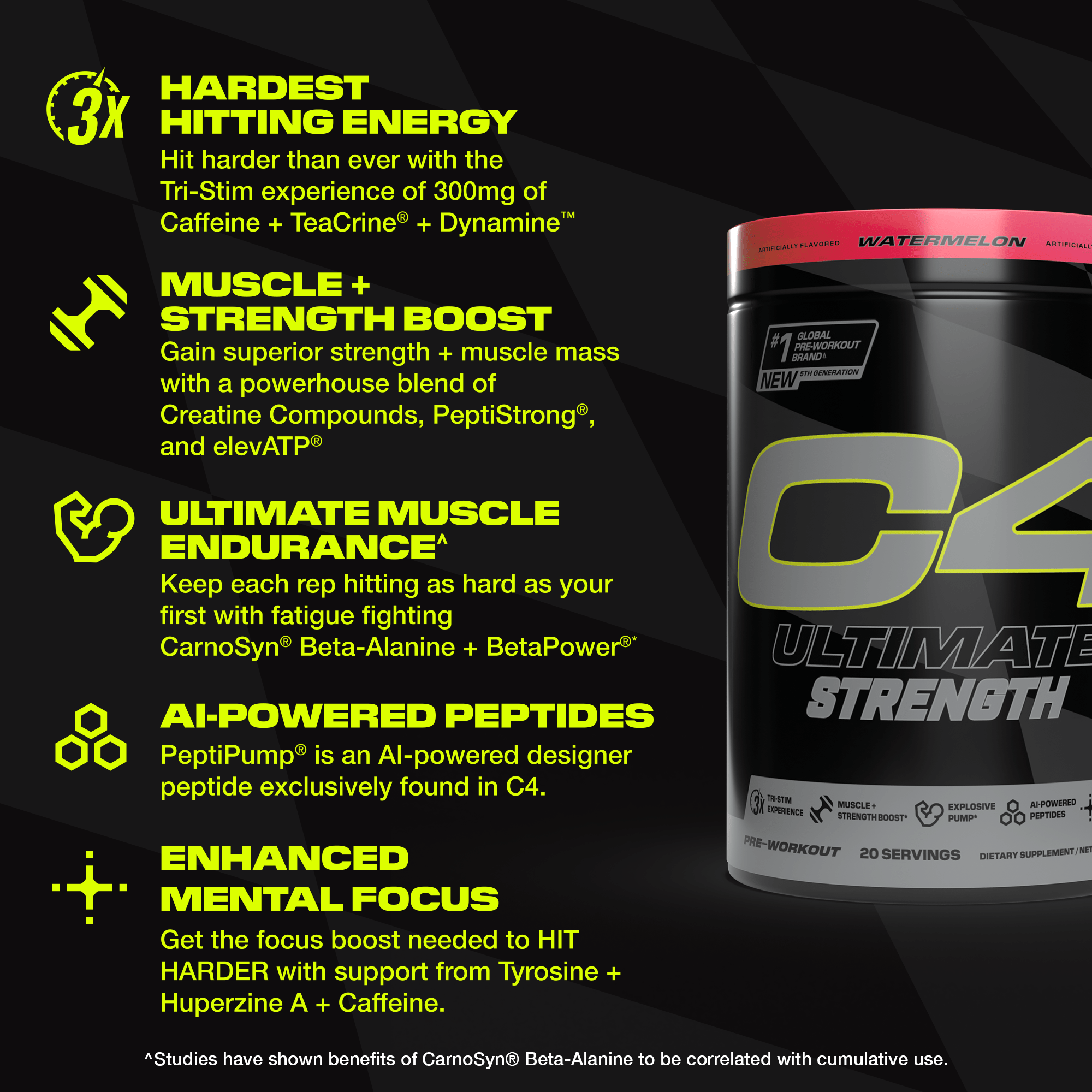

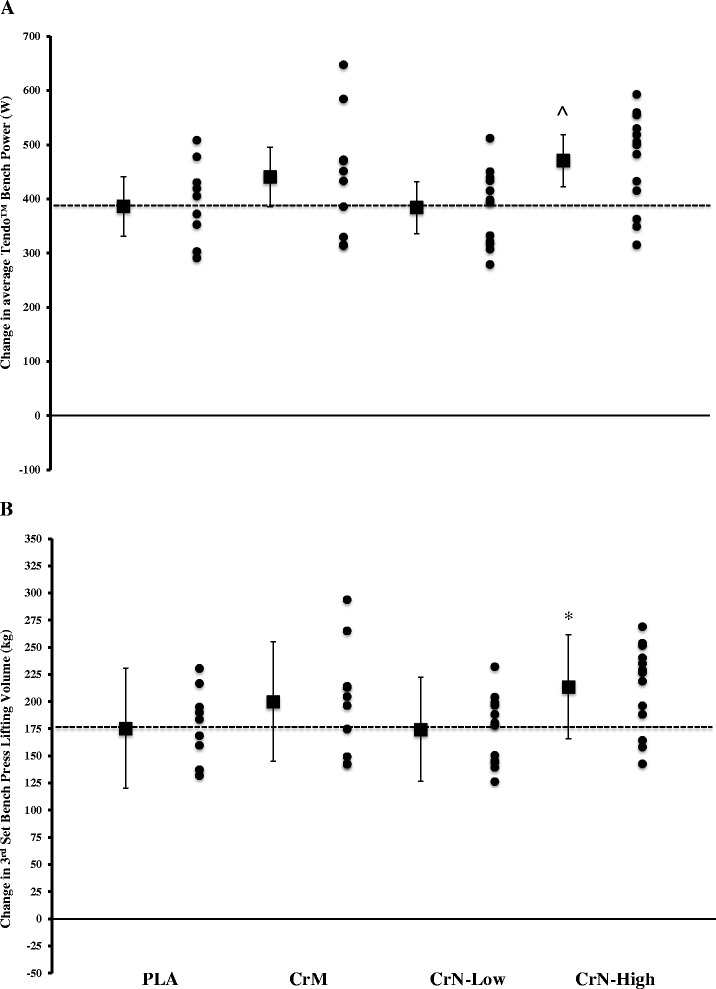
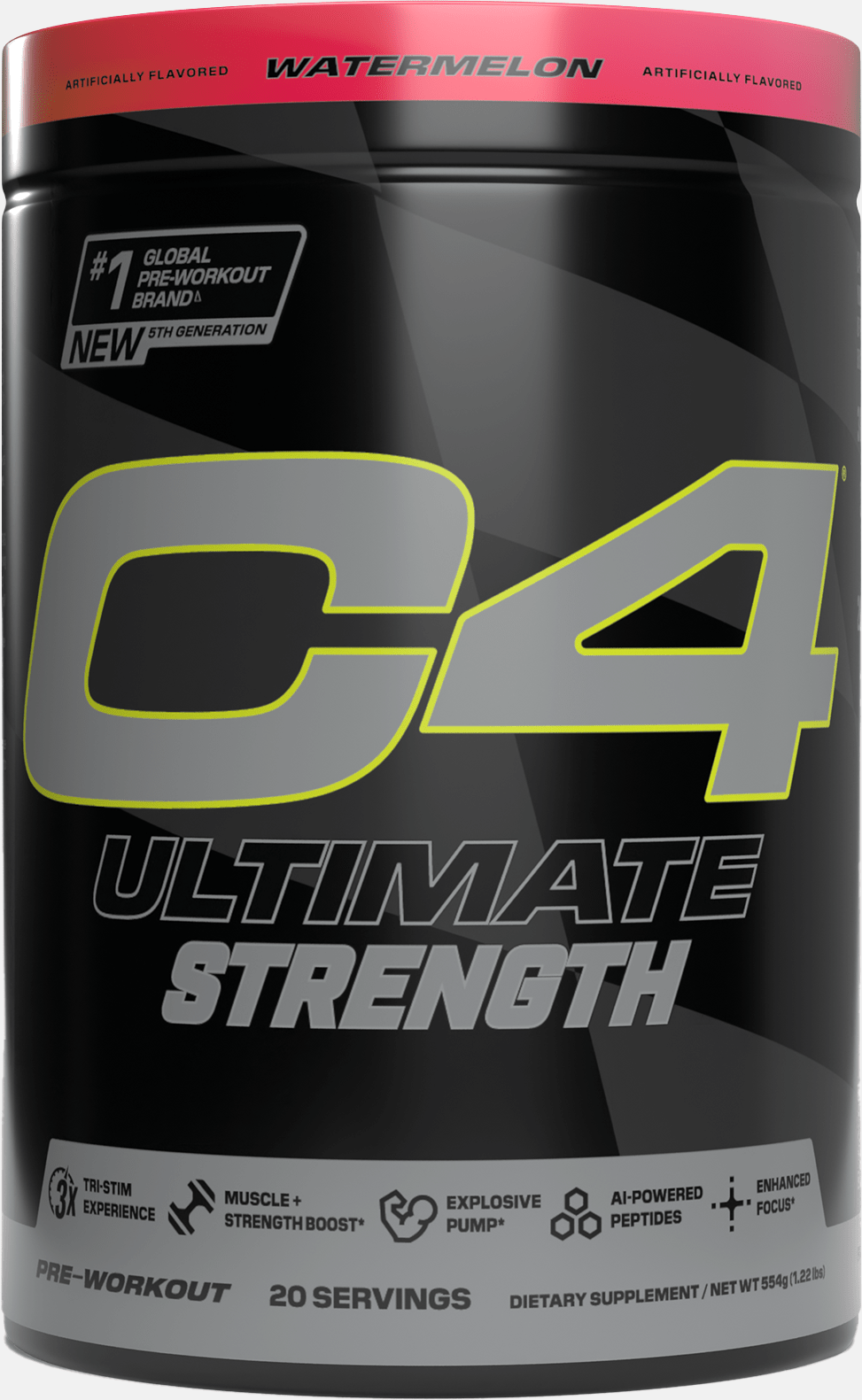


Comments and Discussion (Powered by the PricePlow Forum)